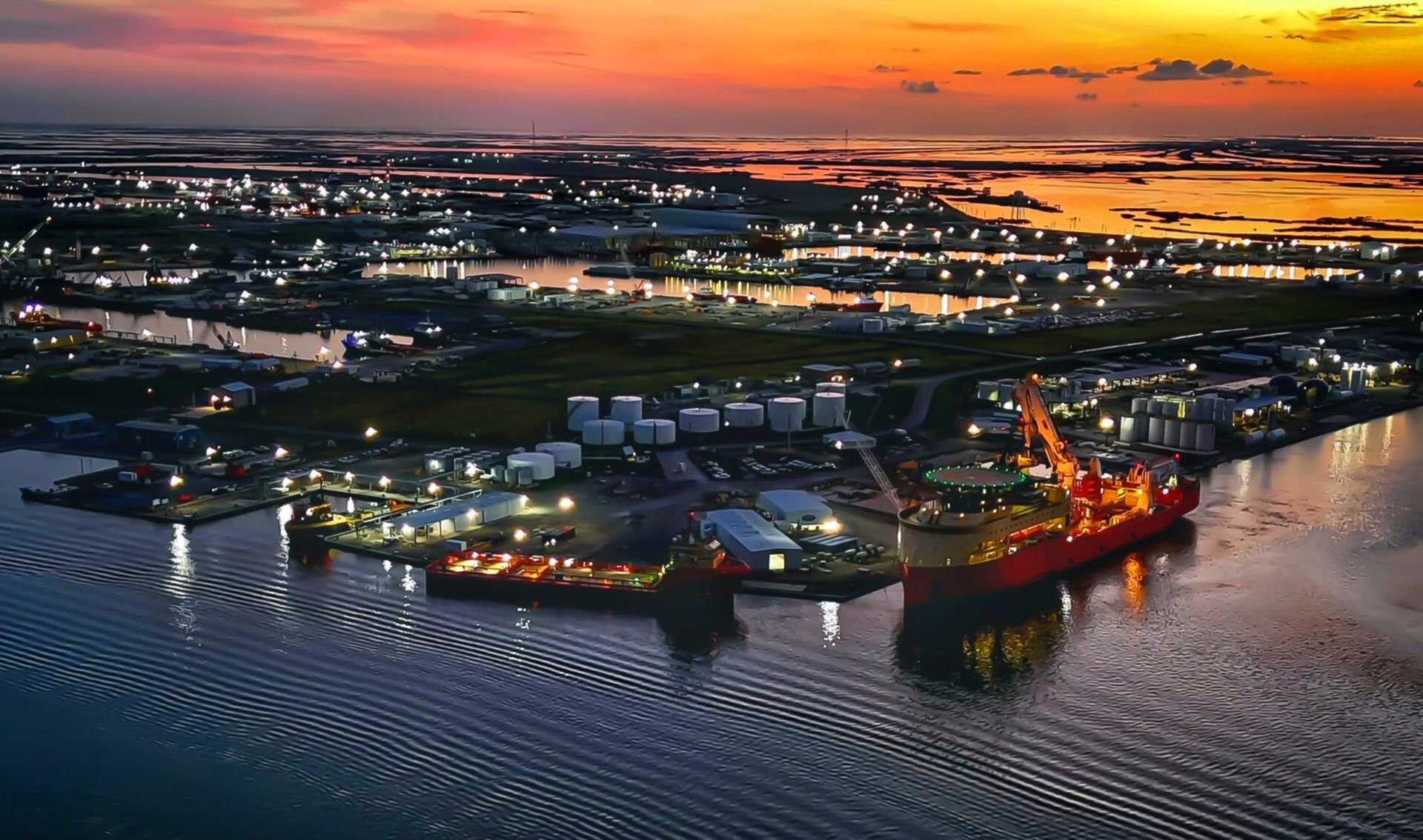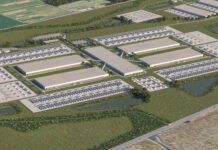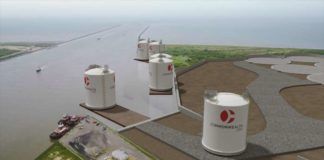Chett Chiasson isn’t interested in competing with any of Louisiana’s other ports. There’s really no need, since as executive director of the Greater Lafourche Port Commission he’s chasing a distinctly unique holistic vision for Port Fourchon.
Situated a mere stone’s throw from the Gulf of Mexico, the port has always been intimately tied to Louisiana’s offshore oil and gas industry—servicing more than 95% of all Gulf deepwater activities.
WATCH THE VIDEO
Check out our exclusive original video, Port Fourchon: Louisiana’s Power Outlet, for a visual experience of Port Fourchon’s growth.
But these days, Port Fourchon is intentionally pursuing a more diversified agenda with a focus on all things energy. “You won’t hear me talking about cargo and containers–that’s not at all what we’re about,” Chiasson says. “We’re not looking at competing with our brethren across Louisiana.”
It would be an understatement to say that the port and its tenants have endured their fair share of storms, both literally and figuratively, over the last 10 years. When the oil market bottomed out from 2014 to 2016, they were each faced with a difficult decision: Evolve or dissolve.

Then came the COVID-19 pandemic and a devastating blow from Hurricane Ida. Employment in the area dropped from above 100,000 in 2014 to a bottom of 81,000 in 2021.
“That was a mother of a hit,” says economist Loren Scott with Loren C. Scott & Associates in Baton Rouge, who currently forecasts employment in the area to slowly, but steadily, rise to 89,000 by 2026. “Since 2021, they’ve begun to recover, but they’re still a long way below where they were in 2014.”
To survive, Port Fourchon’s tenants have done whatever it takes to stay relevant. Several companies diversified into non-oil and gas related work or shifted into the maintenance and repair side of things.
Edison Chouest, a firm that owns and operates some 300 supply boats servicing the offshore industry, now builds to service the offshore wind industry and other vessels. Bollinger Shipyards, a major shipbuilder in the region, now has a long-term contract with the U.S. Coast Guard to build Fast Response cutters. And marine construction firm Thoma-Sea has shifted beyond the oil and gas market by fabricating research vessels and brown-water barges.

Port Fourchon itself has become particularly adept at navigating the frustratingly slow and tedious waters of state and federal regulations to fund a variety of infrastructure and dredging projects, while also adopting an “all things energy” mindset.
As a result, they’re evolving into a testbed, of sorts, for innovation as they pursue investors in offshore wind, hydroelectric power, LNG, coastal restoration and offshore platform fabrication and decommissioning.
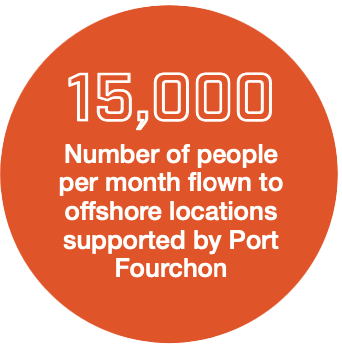 It plays into Chiasson’s mindset of holistic resiliency, whereby industry and the environment aren’t competitors, but collaborative partners.
It plays into Chiasson’s mindset of holistic resiliency, whereby industry and the environment aren’t competitors, but collaborative partners.
“They work very well together,” Chiasson says. “We all must live in the same happy world. Bottom line: We want a good economy, good environment and the ability to provide energy.”
Jonathan Bass, CEO of Argent LNG–who hopes to build an LNG export facility on port property–credits Chaisson’s evolutionary vision for growing the port in the face of some rather daunting odds.
“What was Port Fourchon 15 years ago? What has Port Fourchon become today? It’s a completely different animal,” Bass says. “Chett’s strength is that he goes out there and does the heavy lifting. I’ve seen him in Washington D.C. more than Louisiana. He’s out there pushing forward with his vision.”
Christy Zeringue, incoming CEO of the South Louisiana Economic Council in Thibodaux, didn’t hesitate to ask Chiasson to become the council’s board chairman after assuming her new role this fall following the retirement of Vic LaFont. “I knew exactly who to call,” Zeringue says. “He’s a visionary, a pioneer in this energy addition space.”
She says it’s Port Fourchon’s comprehensive approach to energy that is catching everyone’s attention. SLEC works with Port Fourchon as a liaison and facilitator. “They’re leaders in the energy space. They’re adding a land-based windmill at the port … how many other places can say that they’re doing that? How many ports?
“My challenge is that we need to tell our own story … that way we can set the narrative about how uniquely poised we are to bring in all these different energy industries. And that we have a skilled workforce that can either be retrained or reskilled, so they have the certifications they need.”
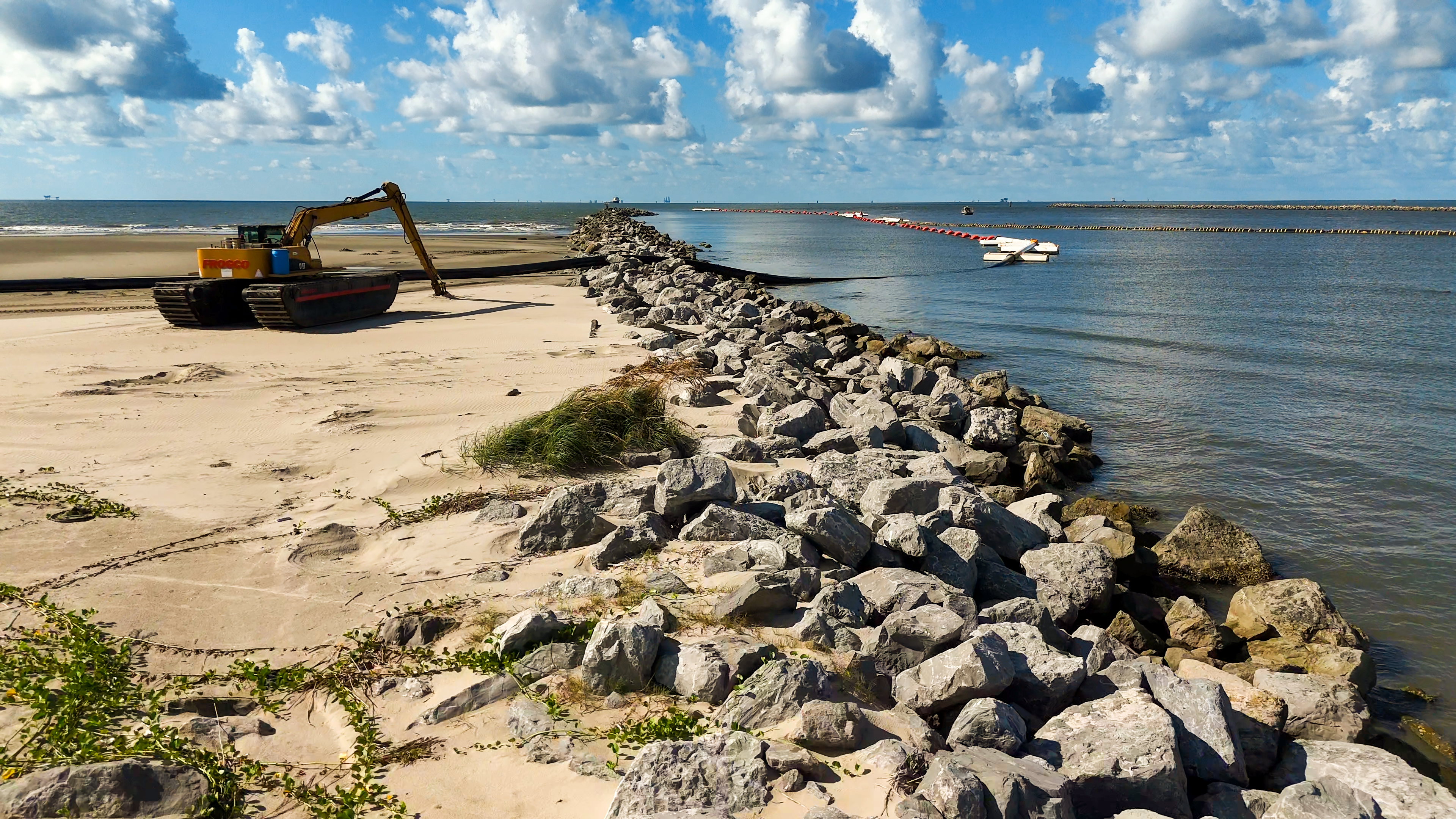
An Evolving Master Plan
Chiasson and the port were in the process of developing a master plan when the oil market bottomed out a decade ago—a painful hit that only served to accentuate the need for a new strategy. The contents of the plan are now being played out, with just more than $270 million in capital projects scheduled over the next two years.
A few of the more significant include:
• The development of Fourchon Island, a proposed deepwater port south of the existing facilities. A total of $200 million is projected for the development, which will focus on offshore wind and offshore rig repair, refurbishment and decommissioning. Leases have already been signed with C-Logistics, Bollinger Shipyards and Gulf Island Shipyards. Permits are expected later this year.
• The purchase of 850-acre Caillouet Island, which will provide unrestricted access to Port Fourchon Island and be supported by a new Fourchon Bridge. The port is also donating 165 acres to the state for the creation of a Coastal Wetlands Park. The $700,000 attraction is set to begin construction in late 2024 and will include an elevated viewing tower.
• The $1.1 million installation of Louisiana’s first wind turbine by Gulf Wind Technology in Avondale. The 200KW to 300 KW of power generated by the turbine will be used for the port’s operations center and the Coastal Wetlands Park viewing tower. Construction of the turbine foundation is set to begin late this year.
• A new $4.3 million, 6,000-square-foot terminal at South Lafourche Leonard Miller Jr. Airport, which is under the port’s jurisdiction. The airport supports numerous helicopter and fixed-wing flights and is used heavily by the offshore oil and gas industry.
 “Closely related to the port is a $411 million project by Entergy to construct the Bayou Power Station,” Scott says in his recently released Louisiana Economic Forecast. “This will be a floating natural gas-powered station to provide power to Port Fourchon, Golden Meadows, Leeville and Grand Isle.”
“Closely related to the port is a $411 million project by Entergy to construct the Bayou Power Station,” Scott says in his recently released Louisiana Economic Forecast. “This will be a floating natural gas-powered station to provide power to Port Fourchon, Golden Meadows, Leeville and Grand Isle.”
From atop a barge across from a substation in Leeville, the 112 MW power station would provide much-needed redundant power. “This will give them the ability to provide more resilient rapid startup capability and give us a more reliable and resilient power grid,” Chiasson says.
The port executive is particularly excited about recent successes in garnering federal funding for dredging activities that will ultimately accommodate a wider range of tenants.
“We’ve been finalizing all our approvals and working with different agencies for an initial deepening project that will take us from 27 to 33 feet. That should start before the end of the year,” he says. “It will allow our tenants to be more efficient in serving the larger vessels that are already using the port.”
More importantly, potential funding from the federal Water Resource Development Act could facilitate the dredging of the southernmost section of Bayou Lafourche to a depth of 50 feet, critical to the development of the Fourchon Island deepwater port and the proposed Argent LNG facility.
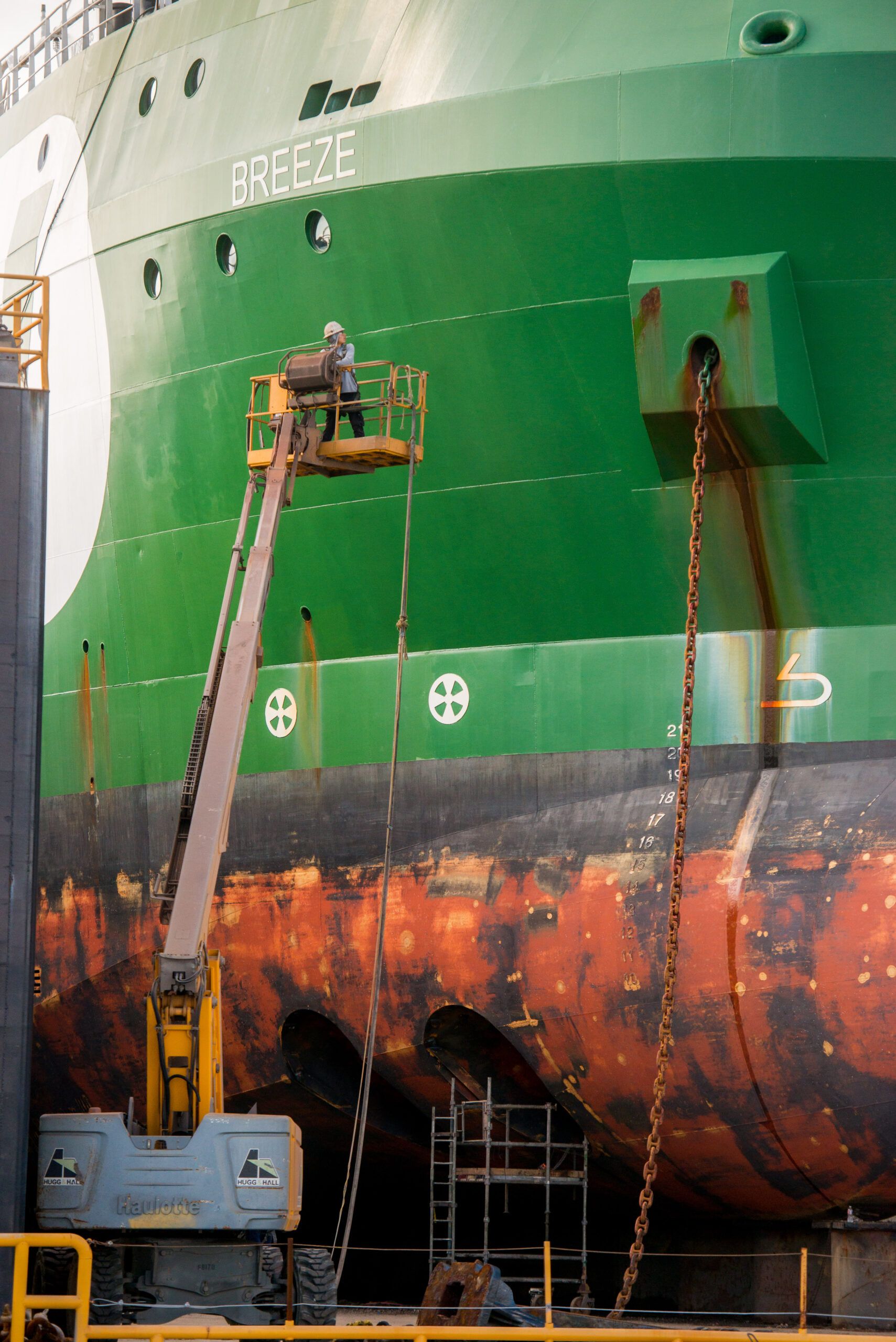
“Fortunately, about half of Fourchon Island is already under lease to Bollinger Shipyard, Sea Logistics and Grand Isle Shipyards,” Chiasson says. “By having it leased, we can go to the Corps of Engineers to demonstrate the need for the 50-foot draft. You’ve got to have the chickens before you can build the coop.”
Once permits are received, it will take the port nearly a decade to create the island, as the project calls for transforming about 900 acres of marshland into a new 500-acre development.
The port administration is also waiting on another supportive infrastructure project: A 9-mile stretch of elevated LA 1 leading to Port Fourchon, set for completion in late 2027. “That is a major piece of infrastructure that will provide long-term resiliency for the port and for accessing the port,” Chiasson says.
A Vision for Wind
Port Fourchon’s willingness to embrace all things energy has led to an implausible partnership in recent months. By year’s end, Gulf Wind Technology expects to begin constructing the foundation for the state’s first wind turbine at the port’s Coastal Wetlands Park.
The 187-foot-tall turbine will collect data and potentially power the port’s nearby emergency operations building.
 “When I found out the port had an appetite for embracing renewable energy, we hit it off,” says James Martin, CEO of Gulf Wind Technology in Avondale. “Chett talked about the vision he had for the area, and we began performing a wind assessment and working with the port to determine the right location. They’ve been cutting edge on their designs for the future state of what a wind port could look like.”
“When I found out the port had an appetite for embracing renewable energy, we hit it off,” says James Martin, CEO of Gulf Wind Technology in Avondale. “Chett talked about the vision he had for the area, and we began performing a wind assessment and working with the port to determine the right location. They’ve been cutting edge on their designs for the future state of what a wind port could look like.”
Earlier this year, the turbine and its components arrived at Avondale Global Gateway after a transatlantic journey from Ireland. Since then, Gulf Wind Technology has been testing the technology in a wind tunnel at its facility.
“Our objective is to install a technology demonstrator turbine at Port Fourchon,” Martin says.
“It is an example of a small robust turbine that we are going to adjust so that it can operate in the low wind speed environments of the Gulf and be resilient against peak wind events.
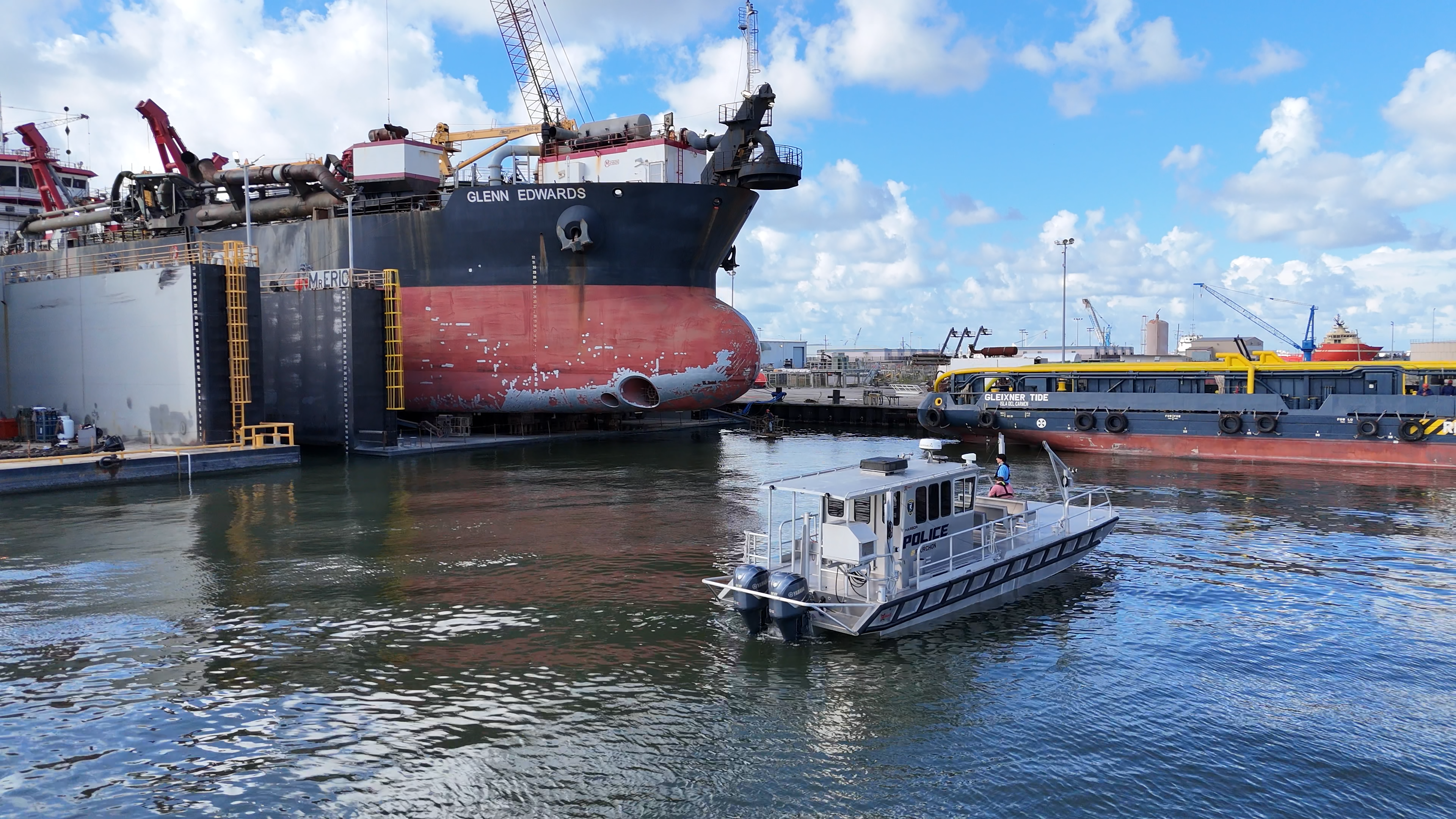
“The project is also demonstrating that the port can handle the components of the turbine, such as the tower, gearbox, generator and blades. We wanted to showcase that you can import, store on site etcetera,” he adds. “The aim for this turbine is that it’s going to have new technologies installed on it on a rotating basis. Every season we might put a new set of blades on it, or we might put new sensors on it.”
Martin expects the turbine to be producing power by the end of Q1 2025. “But there’s really no rush … we’ll have just as much enjoyment planning the project and putting the project together than we will in seeing the turbine spin,” he adds. “That’s the cherry on the top, but the journey is equally valuable.”
Once it’s operational, Chiasson hopes to showcase his port as a national leader in the servicing of offshore wind power. “If offshore wind does take off in the Gulf, we certainly believe and know that Fourchon is going to play a role in that industry because of the supply chain that already exists and the expertise we have in servicing offshore industry,” he says.
The port is also picking up a related tenant: Crowley Offshore Wind, which plans to spend $50 million a year through 2026, with the anticipation that it will service offshore wind developments in state waters.
“Businesses here are already working in the northeast on offshore wind projects (such as Block Island Wind Farm),” Chiasson says. “That expertise can transition easily. They’re still working offshore, still loading and unloading heavy stuff … it’s still part of that offshore process and we have that expertise here. Whatever type of energy we’re talking about, if it happens offshore, we’re going to play a role in it.”
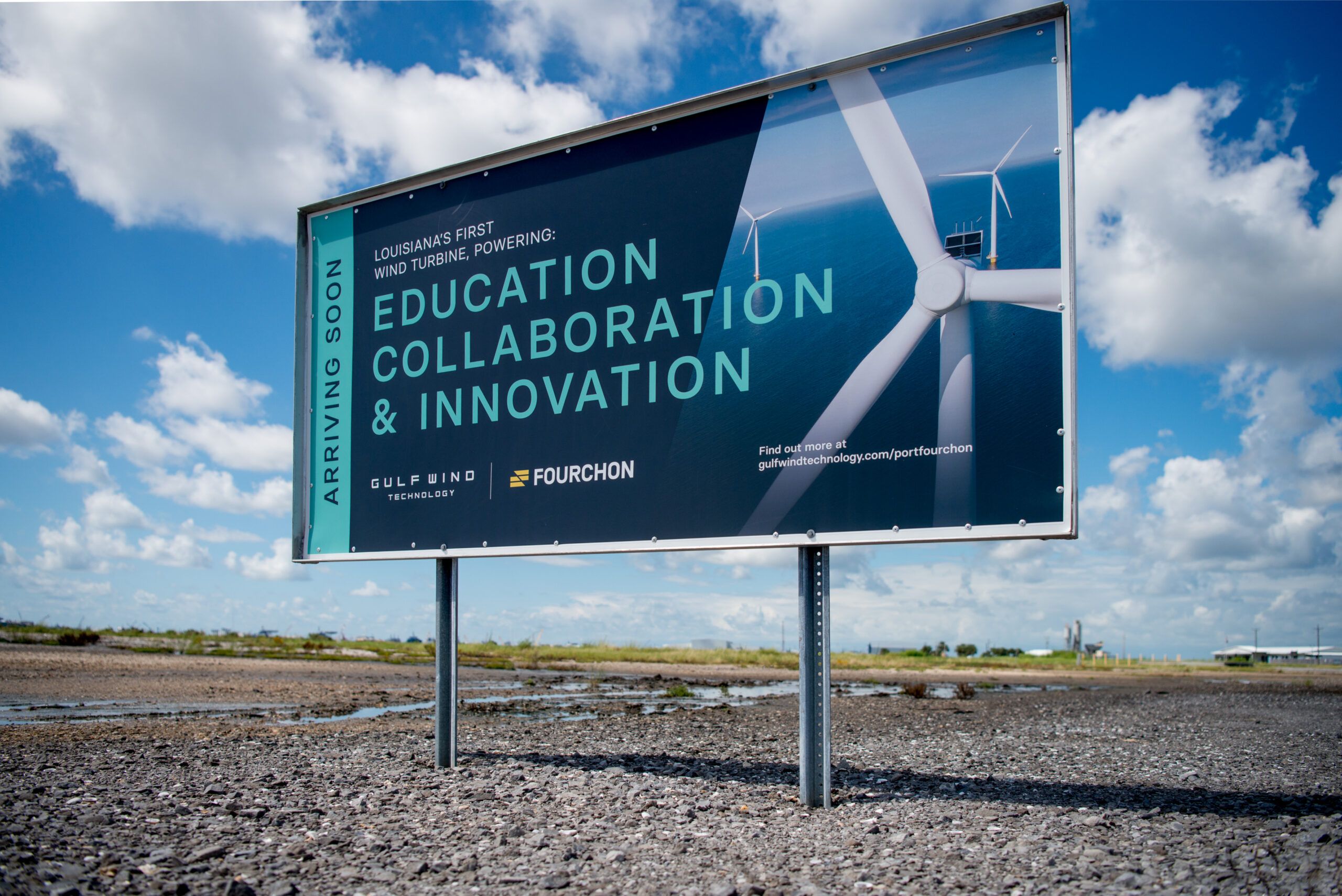
It’s all About Proximity
Port Fourchon’s biggest attribute is “location, location, location,” says Argent LNG’s Bass. “The port checks every box. There’s proximity to a pipeline … we’re only 1,500 yards from it, and there’s a community and a local government that’s supportive of the project. Then there’s the community … Chett can’t go a week without people in the community asking him about the LNG project.”
Bass expects his proposed $10 billion, 20 million tons-per-year facility to begin the FERC pre-filing process this fall. If approved–which could take up to two years–Argent would take delivery of its first module 18 months later, with subsequent modules following every one to two months until completion.
Earlier in the year, Argent tapped Worley as its EPC and development partner, with Worley’s initial focus being the development of site layouts and the selection of process technologies. Argent also selected GTT’s cryogenic membrane containment system for the transport and storage of the LNG.
Bass expects about 1,000 permanent jobs to be created by the facility, without another 3,500 construction jobs over a six- to seven-year period. He admits that the project must first overcome some serious headwinds, principally the current federal LNG pause, “but I think we’ll get past all of this anti-gas mentality … it’s the only immediate lever they can pull that’s better than coal.”
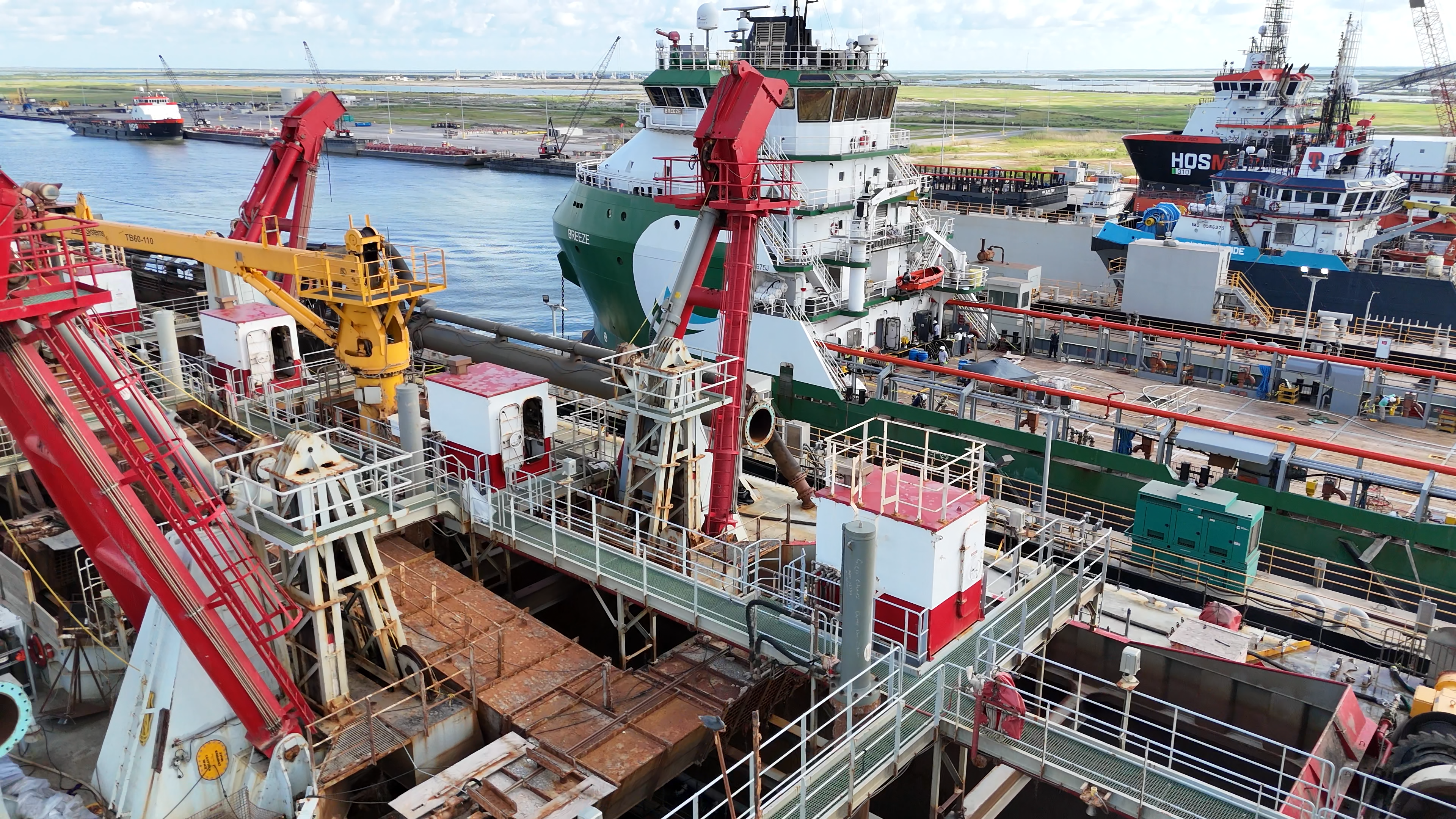
A Good Problem to Have
Tommy Faucheux, president of the Louisiana Mid-Continent Oil & Gas Association in Baton Rouge, says Port Fourchon’s willingness to accept all forms of energy will undoubtedly create jobs in the long run.
“A lot of those service companies are going to need opportunities to grow, expand and diversify,” Faucheux says. “And at Port Fourchon, they’re the world’s experts in operating in the Gulf. If they can service the oil and gas industry, they’re absolutely capable of servicing offshore wind or something else.
“I think it’s great for Louisiana business, because they’re playing a critical role in the industry’s success at home. It creates long-term job protection.”
But as projects ramp up, it could serve to exacerbate a lingering and persistent problem for the Bayou Region: an alarming lack of workers. “There was a large segment of the population that just threw up their hands and said I’ve had enough after Hurricane Ida,” Scott says. “And I’m sure Francine, although not as bad, will reinforce that a bit.
“Gulf Island Shipyards was forced to hire international crews to work its offshore rigs,” he adds. “They’re having to fill these jobs somehow. The jobs are there, but they’re having a hard time finding people.”
SLEC’s Zeringue agrees that it’s the workers, not the jobs, that are scarce. That’s why workforce development has become a particularly important focus for the council in recent years, in addition to business retention and recruitment.
Faculty members from Nicholls State University’s College of Business Administration and Fletcher Technical Community College are on the SLEC board to facilitate the workforce discussion. They also get input from South Louisiana Community College. “Through their collaboration, they’re able to quickly put together programming for maritime management, welding certifications, etcetera, to meet the needs of industry.
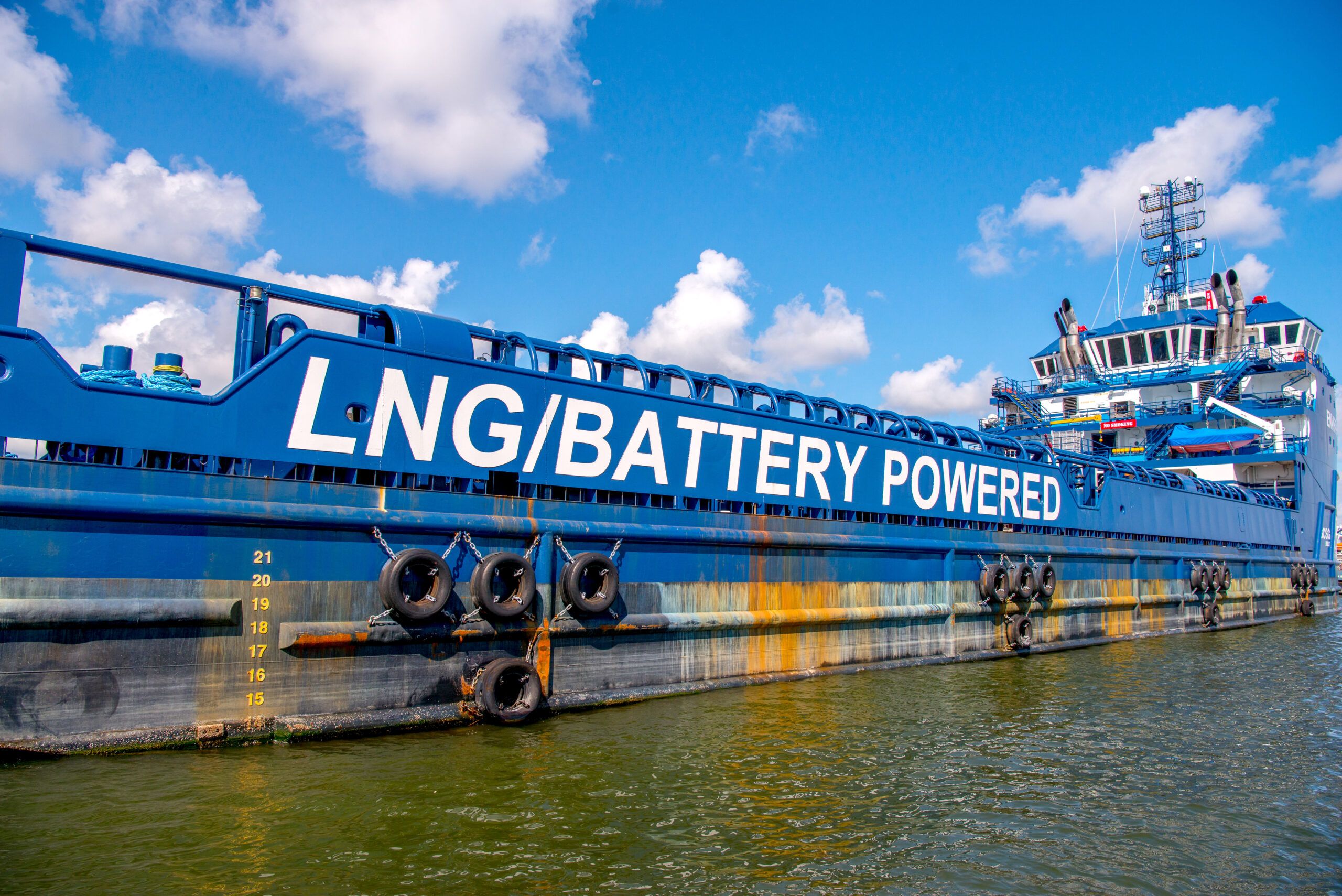
“We have meetings with them where we bring in our industry partners to find out where the gaps are,” Zeringue says. “When the industry folks can tell our higher education folks where the gaps are, as well as how much they’re offering in salaries, that generates a lot of interest. They’re also helping fund some of the training through donations, or in-kind donations, to facilitate the training.”
Chiasson says irrespective of the challenges, there’s palpable excitement at Port Fourchon these days. In fact, he’s had three serious inquiries into port properties in just the last month.
“We have our ear to the ground, and we’re always willing to listen and talk. While our niche remains the daily servicing of energy exploration and production, we’re open to anything that creates jobs for our region.”

